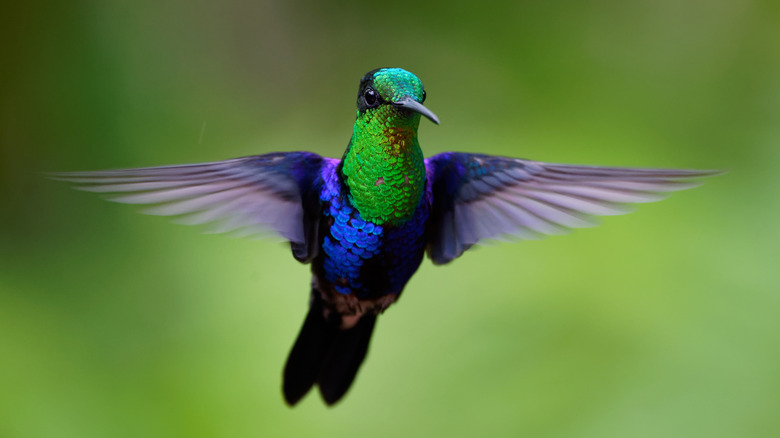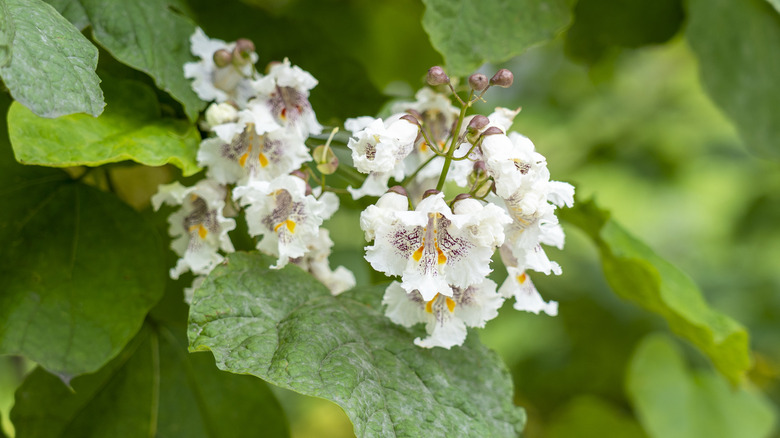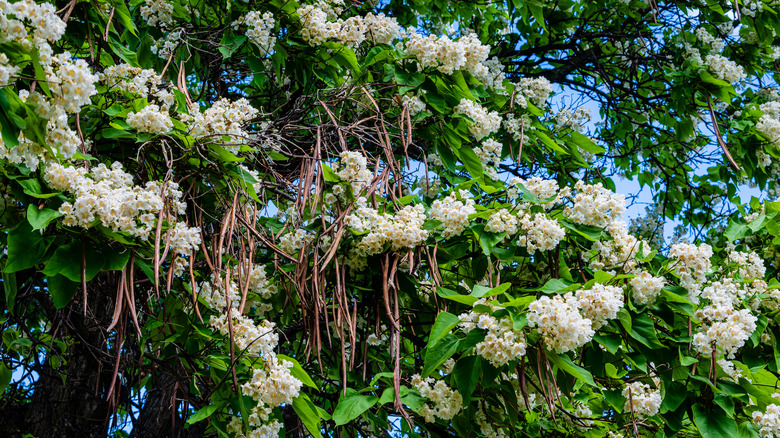Hummingbirds Love This Fast-Growing Tree And All Of Its Benefits
Hummingbirds are delightful spring and summer visitors. Their vibrant colors and quick movements make them a treat to spot in the wild. But you can also make your own home one of their favorite places to visit. You can put out a few types of hummingbird feeders or you can plant a Northern catalpa tree, which is a great way to attract hummingbirds to your yard. The tiny birds are attracted to its white orchid-like blossoms.
Tubular-shaped flowers are a favorite of hummingbirds to feed on. The long, narrow shape often makes it difficult for pollinators like bees, butterflies, and moths to access the nectar. However, because hummingbirds have long tongues and bills, they can drink the nectar with no problem. And a dense cluster of flowers allows hummingbirds to stay in one area while they feed rather than having to fly from one flower to the next.
The Northern catalpa tree has clusters of tubular-shaped flowers, which make it an ideal feeding spot for hummingbirds. So, if you're looking to attract more hummingbirds to your yard, this is a tree to consider. Plus, it is a relatively easy-grower, so you won't have to agonize over its care.
Growing a Northern catalpa tree
The Northern catalpa tree (Catalpa speciosa) is deciduous and a perennial, meaning it drops its leaves in the fall and the flowers grow back each year. This tree thrives in USDA Hardiness Zones 4 through 8, which encompasses the majority of the United States. As stated, this tree is relatively easy to grow, so most people can plant it in their backyards as it can grow in normal or clay soil as long as it is well-draining. A mature tree can grow between 40 and 60 feet tall and 25 and 40 feet wide, providing great shade in the backyard.
Once you plant the tree, it takes about six weeks for the roots to establish themselves in the soil. During the initial planting period, you should water the tree every two to four days for the first six weeks. This ensures the roots are getting enough water to settle in the ground. After the first six weeks, you can switch to watering once a week. Once the roots have been established, the tree becomes fairly drought-tolerant, another major benefit of the Northern catalpa. It will continue to thrive even if it goes without water for a few days or a couple of weeks. However, you'll want to ensure you water the tree if the area hasn't received rain for more than a few weeks at a time. With proper care, the flowers blossom by late June, which is when you can expect them to attract hummingbirds to your yard.
Where to plant Northern catalpa tree
This tree grows quickly, especially as a newly planted tree. The growth rate tends to slow as the tree ages and matures. However, flowers will start blooming after it has matured to between five and seven years. So, if you grow this tree from a seed or sapling, you'll have to nurture it a bit before it bears flowers that will attract hummingbirds. If you want a more immediate option, you can purchase a mature Northern catalpa at least five to seven years old from a nursery or online and transplant it into your yard. These trees are more likely to grow flowers quickly, which means you can have hummingbirds in your yard sooner.
Besides its easy growing requirements and faster growth rate, one of the major benefits of the Northern catalpa tree is that it can grow in sun, partial sun, and shady areas. This means if you have some uneven light or your backyard receives inconsistent light throughout the day, you can still easily grow this tree. Growing this tree in partial shade also benefits hummingbirds, as they don't like to be in the sun for too long. Providing them some cover from the sun while they feed allows them to conserve energy. So, the Northern Catalpa has proven to be a low-maintenance tree you'll want in your landscaping to attract hummingbirds.


